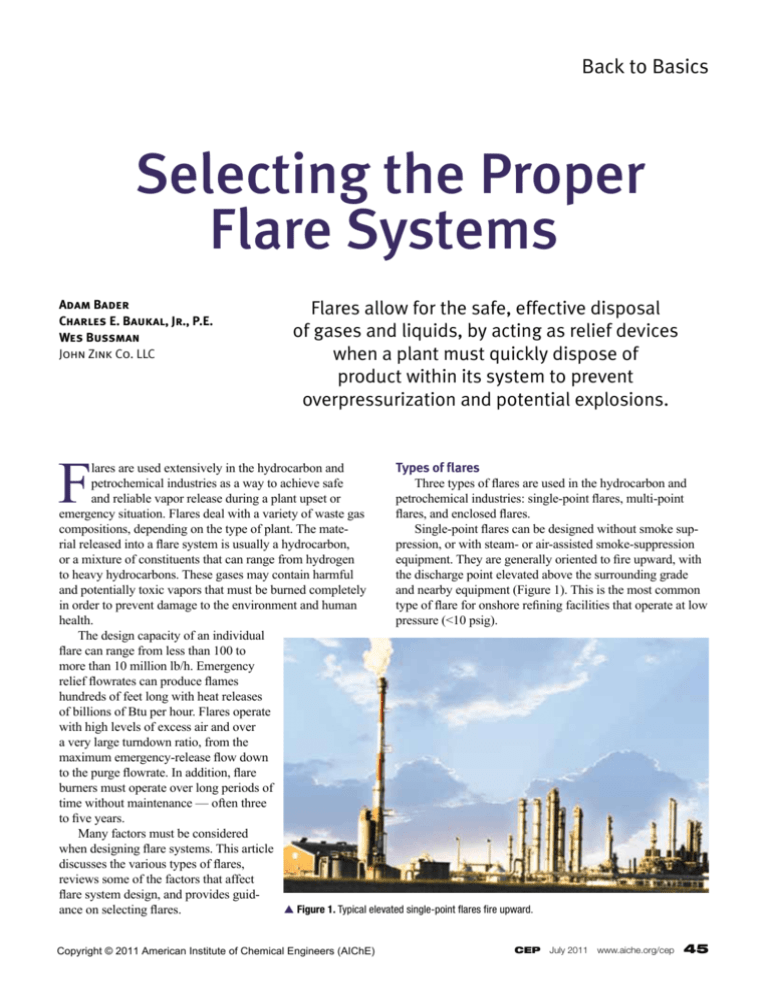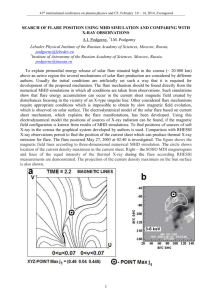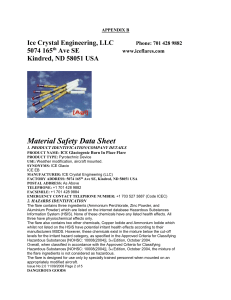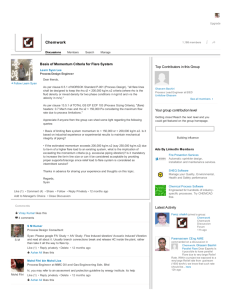Selecting the Proper Flare System
advertisement

Back to Basics Selecting the Proper Flare Systems Adam Bader Charles E. Baukal, Jr., P.E. Wes Bussman John Zink Co. LLC Flares allow for the safe, effective disposal of gases and liquids, by acting as relief devices when a plant must quickly dispose of product within its system to prevent overpressurization and potential explosions. F lares are used extensively in the hydrocarbon and Types of flares petrochemical industries as a way to achieve safe Three types of flares are used in the hydrocarbon and and reliable vapor release during a plant upset or petrochemical industries: single-point flares, multi-point emergency situation. Flares deal with a variety of waste gas flares, and enclosed flares. compositions, depending on the type of plant. The mate Single-point flares can be designed without smoke suprial released into a flare system is usually a hydrocarbon, pression, or with steam- or air-assisted smoke-suppression or a mixture of constituents that can range from hydrogen equipment. They are generally oriented to fire upward, with to heavy hydrocarbons. These gases may contain harmful the discharge point elevated above the surrounding grade and potentially toxic vapors that must be burned completely and nearby equipment (Figure 1). This is the most common in order to prevent damage to the environment and human type of flare for onshore refining facilities that operate at low health. pressure (<10 psig). The design capacity of an individual flare can range from less than 100 to more than 10 million lb/h. Emergency relief flowrates can produce flames hundreds of feet long with heat releases of billions of Btu per hour. Flares operate with high levels of excess air and over a very large turndown ratio, from the maximum emergency-release flow down to the purge flowrate. In addition, flare burners must operate over long periods of time without maintenance — often three to five years. Many factors must be considered when designing flare systems. This article discusses the various types of flares, reviews some of the factors that affect flare system design, and provides guidp Figure 1. Typical elevated single-point flares fire upward. ance on selecting flares. Copyright © 2011 American Institute of Chemical Engineers (AIChE) CEP July 2011 www.aiche.org/cep 45 Back to Basics flowrate that will allow the plant to start up, shut down, and operate on a day-to-day basis without flame exposure. Multiple enclosed flares are sometimes used to conceal the flames at higher waste gas flowrates. Typically, only a fraction of an enclosed flare system is used for normal low flowrates; at higher flowrates, additional stages open as more flaring capacity is needed. This helps to maximize a unit’s efficiency at all flowrates. p Figure 2. Some multi-point flare systems are located at or near grade. Image courtesy of CRC Press (7). p Figure 3. Other multi-point flare systems are elevated. Multi-point flares are used to achieve improved burning by routing the gas stream to many burning points. The multiple burning points, which may be divided into stages, can be arranged in arrays located at or near grade (Figure 2) or on an elevated boom (Figure 3). For refinery or petrochemical plant applications, multi-point flares are usually designed to achieve smokeless burning and typically require a minimum system pressure of 15 psig. Enclosed flares (Figure 4) conceal the flame from direct view, and reduce noise and p Figure 4. Enclosed ground flares shield the surrounding thermal radiation to the surcommunity from radiation and rounding community. The noise. Here, an enclosed ground flare is seen with an elevated flare capacity of the enclosed flare system is often limited to a in the background. 46 www.aiche.org/cep July 2011 CEP Flare design The specific design of a flare system depends on the type of flare. The major components include the flare burner (with or without smoke-suppression capability), support structure, piping, and ancillary equipment (Figure 5). The burner often includes one or more pilots, pilot igniters, and pilot flame detectors. Optional components, which can aid system operation and/or reduce costs, may include a purge reduction device, knockout drum, and liquid seal. Potential auxiliary equipment includes smoke-suppression control, blowers, staging equipment, monitors (e.g., for monitoring flow, gas composition, or heating value, or for video monitoring), and other instrumentation. Flare design also depends on the sources of the gas being vented into the flare header and such gas characteristics as flowrate, composition, and temperature, the available gas pressure, and utility costs and availability. Safety, environmental, and social requirements arising from regulatory mandates, the owner’s basic operating practices, and the relationship between the facility and its neighbors need to be considered as well. Depending on the amount of information available and the scope of the project, additional design considerations may include: hydraulics; liquid removal; air infiltration; smoke suppression; flame radiation, noise, and visibility; the presence of air/gas mixtures; and the need to ensure reliable burning. Successful selection and operation of flare equipment require a clear understanding of these design considerations. The success and cost-effectiveness of a flare design also depend on the skill and experience of the flare designer, and his or her access to the latest state-of-the-art design tools and equipment. A key development tool is a facility that can simulate industrial-scale process-plant flare systems and conduct flare tests at the high flowrates experienced in real plant operations (1, 2) (Figure 6). Flare system sizing must take into account the number of relief valves discharging into a common flare manifold or header. The pressure drop from each relief valve discharge through the flare tip must not exceed the allowable relief valve backpressure for all system flow conditions. For conventional relief valves, the allowable backpressure is typically limited to about 10% of the minimum relief valve upstream set pressure. Copyright © 2011 American Institute of Chemical Engineers (AIChE) Infiltration of air into a flare system can lead to flame burnback (also called flashback), which can initiate a destructive detonation in the system. Burnback is one of the primary modes of premature failure of a flare tip, and can often be observed only at night. Air can enter the flare system in one or more ways: through the stack exit by buoyant exchange, wind action, or contraction of gases due to cooling; through leaks in piping connections; or as a component of the waste gas. Prevention measures are available to address each of the air infiltration mechanisms, such as increased purge gas or the installation of an internal steam nozzle. The quantity of purge gas required to prevent air ingression depends on the size and design of the flare, the composition of the purge gas, and the composition of any waste gas that could be present in the system following a venting or relief event. In general, the lower the density of the gas in the flare stack, the more purge gas is needed to ensure the safety of the system. Various types of auxiliary equipment, such as a velocity seal or buoyancy seal, can be added to a system to reduce purge, but their implementation will depend on the process conditions. utilized, can provide the required momentum. In these cases, a high-pressure flare tip, typically of a multi-point design (Figure 7), is often used. If the waste gas pressure (momentum) is not adequate to provide smokeless burning, other energy sources (e.g., steam or air), or a combination of energy sources, can be used. Steam assist tends to be more effective at achieving smokeless burning than forced-air assist. This is because high-pressure steam can supply more momentum, which enhances ambient air entrainment and air-fuel mixing — key factors in smokeless performance. An air-assisted flare is a good option when steam is not available or when freezing is a concern. At plants that produce steam at different pressure levels, there is often an Flare Tip operating cost advantage to using low-pressure Pilots steam (30–50 psig). The plant designer must balSteam or ance this operating cost Air-Assist u Figure 5. The major Molecular Seal components of a flare system Environmental considerations are the burner, the support As the waste gases are burned, a portion of the heat genstructure (stack), piping, and erated is transferred to the surroundings by thermal radiaancillary equipment such as a tion. Safe design of a flare requires careful consideration of knockout drum and liquid seal. Flare Stack this thermal radiation (3). It is often possible to comply with radiation limits Purge Flare Header by increasing the height of the flare stack or establishing a limited-access zone around the flare. The flare height or size of the restricted area can affect the economics of the plant. For plants with limited plot Waste Gas Knockout Drum Liquid Seal area (e.g., offshore platforms), an enclosed flare may From Process be needed to meet radiation restrictions. Water spray curtains have also been used to control radiation on offshore platforms. Environmental regulations require many flares to meet specific smoke opacity requirements — i.e., they must achieve smokeless operation. For many years, these were often the only regulatory requirements on flares. Current emission standards (4) take into account new testing capabilities and better understanding of flare performance; new regulations are expected to be released by the end of 2011. In general, smokeless burning occurs when the momentum produced by the waste and assist gas streams educts and mixes sufficient air with the waste gas. A key issue is the momentum of the waste gas as it exits the flare burner. In some cases, the waste gas stream is available at a pressure that, if properly p Figure 6. This facility can test flares at the high flowrates experienced during actual plant operations. Copyright © 2011 American Institute of Chemical Engineers (AIChE) CEP July 2011 www.aiche.org/cep 47 Back to Basics the blower requires some time to reach full speed, the complete effect of air injection is not seen until Figure 9d, which was taken just a few minutes later. In general, the blower supplies only a fraction of the combustion air required for smokeless operation — typically 15–50% of the stoichiometric air requirement is delivered into the flame. The remainder of the air required for combustion is entrained along the length of the flame. Unassisted flares use p Figure 7. Multipoint high-pressure p Figure 8. An advanced steam-assisted flare tip (before mounting on a only the waste gas pressure to flare stack) improves smokeless performance. flare tips aid in smokeless burning. entrain air for combustion. The pressure of the waste gas helps advantage against the increased piping costs associated with to mix the gas with ambient air for combustion. High-presdelivering the low-pressure steam to the flare. In addition, sure (15 psig or more) waste streams typically do not require while the flare may achieve the design smokeless rate at the any supplemental assist medium. Appropriately designed maximum steam pressure, steam consumption at turndown systems have successfully handled high-pressure waste conditions may be higher than expected. Because most streams and enjoy low operating costs and excellent service flaring events involve relatively low flowrates, performance life. This type of smokeless burning is often the motive force under turndown conditions must be carefully considered. used in multi-point flare tips (for example, Figure 7). A steam assist can be as simple as a ring installed in the From an environmental perspective, the rate at which upper portion of the stack that injects steam into the interior air is mixed with the waste gas plays a significant role in of the flare tip (Figure 8), around the perimeter of the flare the overall combustion efficiency of a flare system. Many tip, or a more-complicated design that injects steam both regulations require that flares operate with a combustion around the perimeter of the tip and a b through tubes located throughout the interior of the flare tip. The selection of steam assist technology depends on the plant requirements. Air-assist is appropriate for flares where the waste gas pressure is low and steam is not available. Air-assisted flares use a blower to force air to the tip, which is designed to promote airc d fuel mixing and provide stable burning. The supplied air adds momentum and serves as a portion of the required combustion air. Figure 9 illustrates the effect of assist air. The flare in Figure 9a is burning propylene with no assist air. The photo in Figure 9b was taken just after the blower was turned on. Figure 9c shows some improvement in flame stap Figure 9. Air assist is effective at smoke suppression: (a) no blower air; (b) blower is started; (c) air bility and smoke reduction, but because flow is increasing; (d) smokeless burning. Image courtesy of CRC Press (7). 48 www.aiche.org/cep July 2011 CEP Copyright © 2011 American Institute of Chemical Engineers (AIChE) efficiency of 98% or better. This involves balancing the amount of steam or air needed against the amount of fuel being burned, and proper control of the system to achieve this balance is crucial to proper operation. u Figure 10. A flare pilot meters and mixes fuel and air and delivers the mixture to the flare tip. Ignition and detection systems Stable burning must be ensured at all flow conditions. Because venting of waste gases can occur at any time during plant operation, an integrated ignition system (5) that can immediately initiate and maintain stable burning throughout the period of waste gas flow is required. An integrated ignition system includes one or more pilots, pilot igniters, pilot monitors, and a means to stabilize the flame. A reliable ignition system is one of the single most important aspects of a flare tip’s safe operation. In principle, flares that have a continuous pilot flame perform better and are more reliable than those that do not. This is especially true of refinery, petrochemical, and production-field flares because flaring events are often unplanned and unexpected. Such flares may be online for weeks, months, or even years before there is an immediate need for reliable ignition. A notable exception is landfill flares (or biogas flares) that operate continuously at substantial flowrates and include flame monitoring systems that automatically shut off waste gas flow in case of flame failure. Noncontinuous pilots should be considered only for special applications such as these. The number of pilots required depends on the size and type of flare burner. Flare pilots are usually premixed burners designed such that pilot gas and air are mixed together at a point remote from the flare burner exit and delivered through a pipe to the pilot tip for combustion. This ensures that the pilot flame is not affected by conditions at the flare burner exit (e.g., the presence of fluegas, inert gas, or steam). Premixed pilots are also more resistant to wind and rain; some designs can operate in winds of over 150 mph. Pilot gas consumption varies according to the specific flaring requirements; however, there is a practical lower limit to the pilot gas consumption. Reference 6 provides guidance on the proper number of pilots and the fuel flow per pilot as determined by the recommended heat release. The pilot (Figure 10) must meter the fuel and air, mix the fuel with the air, mold the flame into the desired shape, and maintain flame stability. A typical pilot consists of four parts: a mixer or venturi, a gas orifice, a downstream section that connects the mixer and the tip, and a tip (Figure 11). The pressure energy of the pilot fuel aspirates ambient air into the mixer inlet, mixes the fuel gas and air, and propels the mixture through the downstream section and out the pilot tip. All components of a pilot are carefully designed to work together as a system to achieve proper performance. A change in any individual component will affect the rest of the system and hence the operation of the pilot. The key goals for a properly designed pilot are to provide reliable ignition, ensure pilot flame stability, prevent the pilot flame from being extinguished, and provide a long service life. To achieve these goals, the pilot must be able to withstand rain, wind, heat from the flare flame, and direct flame contact. Common pilot problems are failure to light and burn with a stable flame, flashback, and fuel line plugging. A pilot monitor is often required to verify the existence of a pilot flame. Pilot flames produce heat, ionized gas, light, and sound — all of which present a means of detection. The most common flame-detection method involves measuring the temperature at the end of a pilot tip with a standard thermocouple. The thermocouple is connected to a temperature switch or a control system that indicates pilot failure if the temperature drops below the setpoint. In most cases, a shutdown is required to replace a failed thermo- Copyright © 2011 American Institute of Chemical Engineers (AIChE) Pilot Tip Windshield shield Downsteam Section Pilott T Tip Windshield Pilot Tip Mixer Orifice Strainer Downsteam Section p Figure 11. Pilots consist of a mixer or venturi, a gas orifice, a downstream section that connects the mixer and the tip, and a tip. CEP July 2011 www.aiche.org/cep 49 Back to Basics couple. A thermocouple’s expected lifespan can be limited depending on the conditions to which it is exposed. Ionized gases are typically measured with a flame rod. Ions released during combustion act as electrical conductors. A flame-rod transformer located at grade produces a small electrical charge. When a flame is present, the ions act as a conductor and create a closed circuit, indicating the presence of a flame. When the flame is lost, the circuit opens and the control system recognizes the failure, prompting an alarm for relighting. Because a burning pilot flame emits both visible light and infrared energy, the presence of a flame can be verified by monitoring the radiant energy output. Typically, a specially designed infrared camera mounted at ground level is used for flame monitoring. However, optical methods may be unable to distinguish pilots from the main flame or one pilot from another. In addition, the optical path can be obscured by heavy rain, fog, or snow, or any other object blocking the line of sight between the pilot and the camera. Sound-monitoring systems consist of an ignition line that transmits sound from the pilot to grade, where a sensor recognizes the specific frequency at which the pilot operates while burning. A cable conveys the acoustic data from the sensor to a signal processor, which analyzes the acoustic data and indicates the status of the pilot flame. An acoustic pilot monitor can distinguish the pilot to which it is connected from nearby sound sources, such as other pilots, steam injectors, and the flare’s flame. An advantage of acoustic monitoring is that weather conditions do not adversely affect the monitor. Pilots must also have a means of ignition to initiate their flames. As a precaution, pilot ignition is usually initiated from a position remote from the flare stack. Either a Literature Cited Baukal, C. E., Jr., et al., “Large-Scale Flare Testing,” in Baukal, C. E., Jr., ed., “Industrial Combustion Testing,” CRC Press, Boca Raton, FL (2010). 2. Hong, J., et al., “Industrial-Scale Flare Testing,” Chem. Eng. Progress, 102 (5), pp. 35–39 (May 2006). 3. Bussman, W., and J. Hong, “Flare Radiation,” in Baukal, C. E., Jr., ed., “Industrial Combustion Testing, CRC Press, Boca Raton, FL (2010).” 4. Code of Federal Regulations, “General Control Device Requirements,” 40 CFR 60.18. 5. Bellovich, J., et al., “The Last Line of Defence,” Hydrocarbon Engineering, 11 (4), pp. 47–54 (2006). 6. American Petroleum Institute, “Flare Details for General Refinery and Petrochemical Service,” 2nd ed., API Standard 537, API, Washington, DC (Dec. 2008). 7. Schwartz, R., et al., “Flares,” in Baukal, C. E., Jr., ed., “The John Zink Combustion Handbook,” CRC Press, Boca Raton, FL (2001). 1. 50 www.aiche.org/cep July 2011 CEP flame front generator (FFG) or direct-spark pilot ignition can be used, depending on the system requirements. A flame front generator combines ignition fuel and compressed air at a mixing tee, and the ignition gas mixture flows through an ignition line to the pilot tip. After the ignition line is filled with the air-fuel mixture, an electrical spark is initiated at the mixing tee. The air-fuel mixture then ignites, and a fireball travels through the length of the piping until it exits at the pilot tip and ignites the pilot fuel. Various types of electronic ignition systems are available. Many utilize an ignition rod that is installed at the pilot and is connected to a high-voltage transformer. When the transformer is energized, a spark is created at the pilot tip that ignites the pilot fuel. Final thoughts Flare designs range from simple utility flares to enclosed multi-point staged systems, and from unassisted flares to steam-assisted systems with multiple steam injectors to air-assisted flares with multiple blowers. While evaluating the general design considerations discussed here, the process engineer must also begin the equipment selection process by reviewing the available technology — overall design considerations and specific equipment features are interrelated aspects of the system design process. The right choices will help to ensure that the flare’s prime objective is achieved: CEP the safe, effective disposal of gases and liquids. ADAM BADER is an applications engineer for the John Zink Flare Aftermarket Group (11920 E. Apache, Tulsa, OK 74116; Phone: (918) 234-4780; Fax: (918) 234-1986; Email: adam.bader@johnzink.com). He has over six years of experience in the design, application, manufacture, and operation of process flare systems. He has given many training courses on flare design and operation through the John Zink Institute and serves as the training coordinator for the Flare Systems Group. He is the product champion for various John Zink flare technologies and holds a BS in mechanical engineering technology from Oklahoma State Univ. CHARLES E. BAUKAL, Jr., PhD, P.E., is the Director of the John Zink Institute (11920 E. Apache, Tulsa, OK 74116; Phone: (918) 234-2854; Fax: (918) 234-1939; Email: charles.baukal@johnzink.com). He has over 30 years of experience in the field of industrial combustion in the metals, minerals, petrochemical, textile, and paper industries. He has 11 U.S. patents and has authored three books, edited five books, and written numerous technical publications. He holds a BS and an MS from Drexel Univ. and a PhD from the Univ. of Pennsylvania, all in mechanical engineering, and an MBA from the Univ. of Tulsa. He is a Board Certified Environmental Engineer (BCEE) and a Qualified Environmental Professional (QEP), and is a member of the American Society of Mechanical Engineers, the Air and Waste Management Association, and the Combustion Institute. WES BUSSMAN, PhD, is a senior research and development engineer for the John Zink Co. (11920 E. Apache, Tulsa, OK 74116; Phone: (918) 234-5757; Fax: (918) 234-1939). He has 20 years of experience in basic scientific research, industrial technology research and development, and combustion design engineering. He holds 10 patents, has authored several published articles and conference papers, and has been a contributing author to several combustion-related books. He has taught engineering courses at several universities and is a member of Kappa Mu Epsilon Mathematical Society and Sigma Xi Research Society. He received his PhD in mechanical engineering from the Univ. of Tulsa. Copyright © 2011 American Institute of Chemical Engineers (AIChE)






